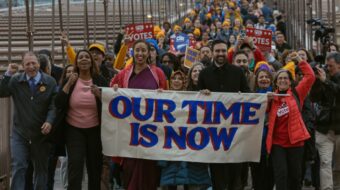Abraham Lincoln composed the first draft of the Emancipation Proclamation for a cabinet meeting in July 1862. He believed, however, that a Union victory on the battlefield was necessary in order that the proclamation would appear both credible and strong. The Battle of Antietam, in which Union troops turned back a Confederate invasion of Maryland – and it remains the largest single day of casualties in our history, gave him the opportunity to issue a preliminary proclamation on Sept. 22, 1862.
As the Civil War progressed through 1862, over rivers of blood that astonished the world, the proclamation drafts became ever more firm, emancipating ever larger shares of the slave population. Following its official invocation, on Jan. 1, 1863, the emancipation erased from history and existence two social classes, two entire ways of life: slaves, and slaveholders. When they were gone, so too went an entire social order, and an entire system of practices, laws, religion, occupations, relations of production, land management, professions, institutions and beliefs. Those familiar with early U.S. history know that this collision did not erupt overnight, but after “four score and seven years” of attempts at compromise. Kansas proved that the nation could not remain “half slave, and half free.” The system of chattel slavery could not, and would not, be “reformed” out of existence, and it could not coexist, even within a single state, with free labor, free soil, or industrial capitalism.
As Fredrick Douglas wrote:
“The Dreadful Calamity came not unbidden,
nor by Accident, nor was the truth from any hidden
Shun not the harvest of blood sown beam-deep
By acts of horror by God forbidden
Repeat not the mistakes of our Fathers known
Because God is not dead, by blood alone
must Slavery fierce and foul have been undone.”
How can this not be called “revolutionary” change? Perhaps the largest armed mobilization in history (up to that time) alongside the suspension of habeas corpus (the right to review arbitrary detention and arrest) – both turned against a nation’s own people – should dispose of any argument that the civil war was a “reform” movement. And yet, the entire rebellion and its complete suppression occurred within a constitutional framework. Powers employed by the president were granted by Congress, and upheld by the Supreme Court. This “constitutional” feature was hardly an unimportant aspect of American success in maintaining its union, and strengthening its democratic republic.
There is an interesting connection between the U.S. Civil War, and the Russian 1905 revolution that, in the end, failed to overthrow the czarist autocracy. In that revolution all forces, including those of the czar, agreed in words with the proposition that there should be a popular “constituent assembly.” However, in reality, no democratic republic could succeed that did not abolish the ancient feudal classes of lords and peasants, and that did not free all those classes bound to “putrid and oppressive relations” (Vladimir Lenin’s phrase).
If the first American revolution of 1775-1783 had not destroyed any chance of such relations overtaking our land from England’s monarchy, we might still be colonies. In a sense, the Russian revolution of 1905 failed because it adopted a “reform” position on social and economic questions that would not wither away of their own accord. The “constituent assembly” founded in that rebellion thus was fatally compromised because it did not accomplish the task of actually constituting itself – which would have required, as did the abolition of slavery in the U.S., force of arms to resolve.
That failure led directly to the 1917 ultimate collapse of the Russian state in the midst of World War I. The Russian Social Democrats, as they were known at the time, with a strong base in the industrial working class, and in the armed forces, proved the only social group sufficiently coherent to get the job of abolishing feudalism done. But they were compelled to do so under the most adverse circumstances imaginable: no constitution, no democratic institutions, and a country starving, destitute and ruined by war. Unlike in the U.S., the emerging capitalist (business) classes could not be persuaded to drop their ties to the feudal system. The salvation of their country fell to Russian workers and peasants alone, a titanic task for which later history perhaps showed they were unprepared, but from which they did not shrink.
Now we are confronted with a question: Is the social and economic class of “finance capitalist” no longer compatible with a genuinely democratic republic? There is no question, in this writer’s view, that they must become LESS powerful, LESS dominant, and a SMALLER component of both our economy and our political system. That’s what “financial reform” is all about. I am currently of the opinion that reform is possible. I do not think the time has come to put this class out of business. But I am not sure we can wait “four score and seven” to find out for sure, given the stakes at hand. History gives contradictory answers.
As Carl Davidson says, we have to keep on keeping on – and the truth will be revealed. Reform, or revolution? Either way, we will make it!










